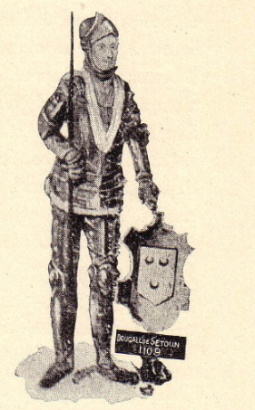|

The Early Seton Family
As
their own distinctive crescents show, Seier de Seton (I) and his brother Walter
sprang from a second son of the house of Boulogne. Known in their Flemish
homeland as Seier and Walter de Lens, they were sons of Count Eustace I ’s second
son, Count Lambert de Lens, whose daughter by a second marriage (to the sister
of William the Conqueror) was the Countess Judith, mother of Scotland’s Queen
Maud.
Count
Lambert died when the boys were too young to administer to the important estate
of Lens, and thus they followed the Flemish military contingent into England
with their half-sister's husband, Duke William of Normandy, in his quest for the
English crown and settled there in the north following William's success. Count
Lambert himself was the second son of his father, Eustace I of Boulogne, and
brother of Eustace II, and they were lineally descended in both Eustace I’s
mother and father from King Charles I, Charlemagne, Holy Roman Emperor and the
first of the Carolingian Empire.
Seier’s eldest son, Walter de Lens, or Walter the Fleming as he is
described in Domesday, had his chief English home at Wahull (now called Odell)
in Bedfordshire. On the Firth of Forth, as heir there of his father, Seier, he
was called Dougall or "the dark stranger", a nickname which was also
given to his own son Walter, and duly recorded by the family’s chronicler, Sir Richard Maitland of Lethington,
in 1554.
The
son of the 1st Seier de Seton, of de Lens, is known as
Dougall de Setoun and his Christian name was Walter, however he
was usually described by a familiar appellation in the language of
the Scots people around him. He was baron of the town and
lands of Setoun and married Janet, daughter of Robert
de Quincy (and not of Roger, who lived a century later) and had a
son also called Seier (2nd) who is often confused with
his grandfather.
The Anglo-Flemings wore a strong coat of mail,
which made them objects of dread and wonder to the Britons,
Saxons, Picts and Celts in whose ancient songs they were called Du-gall,
the “Black Strangers”, from the appearance they made when encased
in armor. This name also came from the French “du Gall”, and
referred to the Galois origins where France was once called Gaul.
Dougall de Setoun, then, literally means “the Black Stranger (and
French lord) of the town and lands of Setoun, and he flourished in
the reign of Alexander I., A.D. 1107-1124.
His wife’s father, Robert de Quincy had
married Maud de St. Liz, daughter of Simon de St. Liz, Earl of
Huntington and Northhampton and Maud, or Matilda, the elder of the
two daughters of Waltheof, Earl of Northumberland and Judith de
Lens, the niece to King William I of England. To appreciate
these ties, note that William married Matilda of Flanders, a
cousin of Dougall. Likewise, Dougall’s grandfather married as his
2nd wife Adele, or Adelaide, of Normandy, William's
sister; it made the Setoun’s cousins of the English King and his sons,
William II and Henry I. Henry I married the daughter of Malcolm
III, King of the Scots; and 2nd, Adela of Bas-Lorraine,
a cousin of Count Lambert Lens, Dougall’s grandfather. Malcom
III’s youngest son, later King David I, married Matilda the 2nd
daughter of Waltheof, Earl of Northumberland. Domesday hints
towards the identity of Count Lambert’s sons: In that book are
just their Christian names; Walter and Seier, and it is obvious
from the wording that Seier is absent. Walter, “brother of Seier”,
was still holding lands in 1086 but Seier’s possessions had been
passed to his elder son Walter (or Dougall), described in the
documents as “Walter Flandrensis” – Walter of Flanders, or the
Fleming. He and his
brother Hugh are given as tenants-in-chief of the vast string of
Midlands manors, and the estates in Scotland, Seier had been
granted lands by the Scottish king, Malcolm Canmore.
It
was during the reign of King David I that the Seton family firmly
established themselves in Scotland, and by all counts,
the early family was one of the most well connected with the early Royal
Houses of Scotland and France, as well as in England.
Almost
two centuries later, the family had firmly established
themselves in the nobility of Scotland, and where Sir
Christopher Seton had married the sister of King Robert I (the
Bruce):
... "the King
of England, having assembled an army, sent my lord Edward, his
son aforesaid (whom he had knighted in London together with
three hundred others), and the Earl of Lincoln, by whose advice
the said lord Edward was to act, in pursuit of the said Robert
de Brus, who had caused himself to be called King. When they
entered Scotland they received many people to peace on condition
that they should in all circumstances observe the law ; then
marching forward to the furthest bounds of Scotland, where the
said Robert might be found, they found him not, but they took
all the castles with a strong hand. But they hanged those who
had part in the aforesaid conspiracy, design and assistance in
making him king, most of whom they caused first to be drawn at
the heels of horses and afterwards hanged them ; among whom were
the Englishman Christopher de Seton, who had married the sister
of the oft-mentioned Robert, and John and Humphrey, brothers of
the said Christopher, and several others with them...".
THE CHRONICLE OF LANERCOST,
1272— 1346
.
| 

